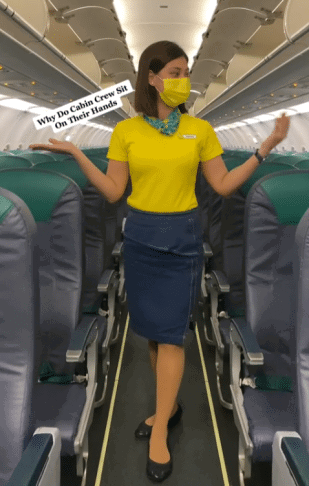In the world of air travel, the duties of flight attendants extend far beyond serving refreshments and ensuring passenger comfort. They are highly trained professionals responsible for the safety and well-being of everyone on board.

The Bracing Position Explained
Passengers may notice flight attendants strapping into their jump seats and sitting on their hands during landings, which often sparks questions. However, Henny Lim, a flight attendant with Cebu Pacific, sheds light on this practice in a viral TikTok video, explaining the purpose behind this seemingly odd position.
According to Lim, the bracing position consists of specific steps: fastening seatbelts securely, sitting upright, placing hands on thighs with thumbs tucked in, keeping arms relaxed, and ensuring feet are flat on the floor.

Purpose of the Bracing Position
The main goal of the bracing position is to reduce bodily movement during emergencies, minimizing the risk of injury upon impact. By securing themselves in a rigid posture, flight attendants are better positioned to endure the forces of a crash landing.
During this time, flight attendants also conduct what Lim calls a “silent review,” mentally preparing for potential emergencies by reviewing safety equipment, door operations, commands, and observing outside conditions.

Insights from Regulatory Authorities
Regulatory bodies like the Federal Aviation Administration (FAA) emphasize the importance of the bracing position. An FAA memo highlights two key functions: reducing flailing of limbs, which could cause additional injuries, and minimizing secondary impact. Prepositioning the body, especially the head, against surfaces likely to be struck during a crash can significantly lessen the severity of injuries.
Flight Attendants’ Perspectives on Safety
Henny Lim’s explanation reflects a growing trend of flight attendants using social media platforms like TikTok to educate the public on safety protocols. Flight attendants like Destanie have also shared viral stories, such as passengers’ attempts to score seat upgrades, while reminding viewers of the importance of following safety rules and respecting the cabin crew’s professionalism.
Challenges and Rewards of the Job
Flight attendants like Destanie and Esther Sturrus offer candid perspectives on the difficulties and rewards of their profession. While they face challenges such as handling difficult passengers and operating in high-pressure environments, they express gratitude for the opportunities and lifestyle the job provides. Despite the challenges, their commitment to passenger safety remains unwavering.
The bracing position during takeoff and landing is more than just a ritual—it is a vital safety procedure designed to protect flight attendants during emergencies. Through insights from professionals like Henny Lim, passengers can better understand the reasons behind this practice and the thorough preparations flight attendants undertake to ensure everyone’s safety.
As flight attendants continue sharing their knowledge and experiences, passengers are encouraged to approach air travel with a greater awareness of the dedication that goes into their safety.

